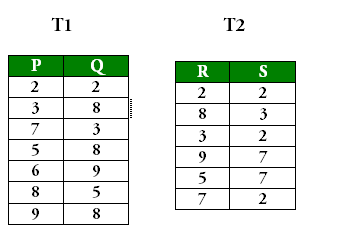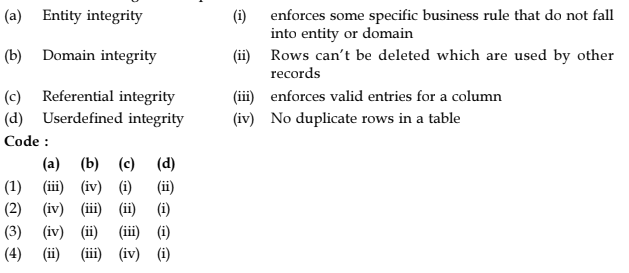ER and Relational Models
Question 21
Consider the join of a relation R with a relation S. If K has m tuples and S has n tuples, then the maximum and minimum sizes of the join respectively are:
Question 22
The relational algebra expression equivalent to the following tuple calculus expression

{ t | t ∈ r ∧ (t[A] = 10 ∧ t[B] = 20 }
is
Question 23
Given two union compatible relations R1(A,B) and R2(C,D). What is the result of the operation
R1⋈A=C∧ B=D R2
A. R1 ∪ R2
B. R1 Χ R2
C. R1 - R2
D. R1 ∩ R2
Question 24
Which of the following query transformations (i.e., replacing the l.h.s. expression by the r.h.s. expression) is incorrect? R1 and R2 are relations. C1, C2 are selection conditions and A1, A2 are attributes of R1.
a. σC1( σC2R1)) → σC2(σC1(R1))
b. σC1( πA1R1)) → πA1(σC1(R1))
c. σC1( R1 ∪ R2 ) → σC1(R1) ∪ σC1(R2)
d. πA1(σC1(R1)) → σC1 (πA1 (R1))
Question 25
A library relational database system uses the following schema
USERS (User#, UserName, HomeTown) BOOKS (Book#, BookTitle, AuthorName) ISSUED (Book#, User#, Date)
Explain in one English sentence, what each of the following relational algebra queries is designed to determine
[caption width="800"] [/caption]
[/caption]
Question 26
Consider the following tables T1 and T2:
 In table T1, P is the primary key, Q is the foreign key referencing R in table T2 with on-delete cascade and on-update cascade. In table T2, R is the primary key and S is the foreign key referencing P in the table T1 with on-delete set NULL and on-update cascade. In order to delete record (3,8) from table, numbers of additional record that need to be deleted from table T1 is ______.
Note: This question appeared as Numerical Answer Type.
In table T1, P is the primary key, Q is the foreign key referencing R in table T2 with on-delete cascade and on-update cascade. In table T2, R is the primary key and S is the foreign key referencing P in the table T1 with on-delete set NULL and on-update cascade. In order to delete record (3,8) from table, numbers of additional record that need to be deleted from table T1 is ______.
Note: This question appeared as Numerical Answer Type.
 In table T1, P is the primary key, Q is the foreign key referencing R in table T2 with on-delete cascade and on-update cascade. In table T2, R is the primary key and S is the foreign key referencing P in the table T1 with on-delete set NULL and on-update cascade. In order to delete record (3,8) from table, numbers of additional record that need to be deleted from table T1 is ______.
Note: This question appeared as Numerical Answer Type.
In table T1, P is the primary key, Q is the foreign key referencing R in table T2 with on-delete cascade and on-update cascade. In table T2, R is the primary key and S is the foreign key referencing P in the table T1 with on-delete set NULL and on-update cascade. In order to delete record (3,8) from table, numbers of additional record that need to be deleted from table T1 is ______.
Note: This question appeared as Numerical Answer Type.Question 27
In an Entity-Relationship (ER) model, suppose R is a many-to-one relationship from entity set E1 to entity set E2. Assume that E1 and E2 participate totally in R and that the cardinality of E1 is greater that the cardinality of E2.
Which one of the following is true about R?
Question 28
Consider the relations r(A, B) and s(B, C), where s.B is a primary key and r.B is a foreign key referencing s.B. Consider the query
Q: r⋈(σB<5(s))
Let LOJ denote the natural left outer-join operation. Assume that r and s contain no null values.
Which one of the following is NOT equivalent to Q?
Question 30
Consider the following schema :
Sailors (sid, sname, rating, age) Boats (bid, bname, colour) Reserves (sid, bid, day)Two boats can have the same name but the colour differentiates them. The two relations
ρ (Tempsids, (Ⲡ sid, bid Reserves)/(Ⲡ bid ( σ bname =\'Ganga\' Boats))), Ⲡ sname (Tempsids ⋈ Sailors)If / is division operation, the above set of relations represents the query
There are 74 questions to complete.
Last Updated :
Take a part in the ongoing discussion
